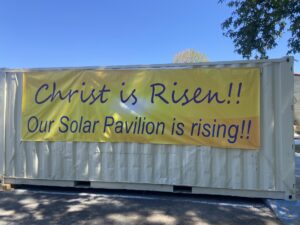The Bishop’s Commission on Climate Change (BCCC) is asking all congregations to assign or elect a liaison, in a new initiative to share and discuss creation care projects and create direct communication among congregational “green teams” or creation care ministries, and with the BCCC.
Mahri Mendenhall, BCCC member and parishioner at Church of the Epiphany, Oak Park, who is leading the liaison initiative, said that the program is just ramping up, with about 40 liaisons so far, and an initial welcome meeting for the liaisons scheduled for May. She said she would love to one day see a liaison from every congregation, to create a web of mutual creation care inspiration and support.
“We need to do this together,” Mendenhall said. “We need to understand our place in this world and be a part of it for the good. It’s important to all of us, each of us and all of us. And we need your help.”
The role of the liaisons, Mendenhall said, is to share BCCC programs and information with their congregations, and to help their congregation discuss and discern how they can get involved in creation care. Some congregations already have robust creation care programs, while others are yet to get involved, Mendenhall said. Because of this, she said, the program is organic and will evolve based on the needs of the different congregations.
At a minimum level, Mendenhall said, liaisons will get information about BCCC programs and report back to their congregations, but she hopes that there will also be deeper engagement. Mendenhall said the dialogue between the different congregational liaisons as well as with BCCC members could be a way to inspire support new creation care projects.
“We are called by the Bible to be responsible stewards of the earth,” Mendenhall said. “So do it with joy. God looked at what he created and said, ‘This is good.’ This is good, so see the beauty in what we have, and that it is finite and it is not guaranteed.”
Mendenhall said that the work of creation care isn’t always easy, especially when we have to change the way we live. She likes the term ‘creation care,’ she said, because it emphasizes the spiritual connection in our responsibility to steward the earth, instead of just focusing on what’s going wrong. “Let’s come in love,” she said.
Gerrie Maloof and Dick Motika, liaisons from All Saints’, Beverly Hills, are already part of several creation care efforts at the congregation. Motika got involved through the congregation’s solar initiative, and Maloof got involved during a congregation book club reading of a book by climate scientist Katharine Hayhoe. In addition to recently receiving conditional approval of the solar panel project, the Beverly Hills creation care team is working on switching to reusable dishes and utensils and recently underwent an “energy audit” that revealed energy spikes when no one was at the church. They’ve since updated the malfunctioning thermostats, and are saving money as well as energy, Motika said.
Motika said that a galvanizing event for his involvement with creation care was seeing the amount of waste at a recycling site that serves Los Angeles and Beverly Hills. “The volume for our city is almost incomprehensible,” Motika said. “It kind of changes your thinking about how huge the issue is.”
While even the actions of a congregation may be small compared to the scale of the problem, change still has to happen one step at a time, and there’s hope that modeling care for creation can have a ripple effect, Motika and Maloof said. “Better to light one candle than curse the darkness,” Maloof said. She said that incorporating creation care into the congregation may inspire congregants to get involved in creation care in their own lives.
The Rev. Canon Kelli Grace Kurtz, rector at All Saints, Riverside, is involved in the congregation’s ongoing creation care projects, and is becoming involved in the BCCC liaison program, representing the riverside congregation along with Steve Slaten, a member of the BCCC and a key leader in All Saints’, Riverside’s installation of solar power. The church recently replaced many gas appliances with electric, is working to become a disaster resilience center, and is in the process of building a solar panel pavilion, which will provide about 150% of the church’s energy usage based on the average of the past three years.
Kurtz said that creation care is theologically important, but creation care projects are often complicated and expensive, and usually not something congregation leaders know how to do beforehand. “I didn’t learn anything about solar panels and solar energy in seminary,” Kurtz said. “This is the spirituality of care of creation, but we are learning how to fly the plane while we fly the plane. Like electrifying a kitchen, I didn’t know what that was, but Oh, my God, is it related to being good stewards of God’s creation.”
Kurtz said that she hoped liaisons would be able to exchange ideas and share pitfalls, so that creation care projects could become easier down the line as knowledge and experience is built up and shared. “The work of care of creation is neither simple nor inexpensive, and that should be known. Something as simple as getting your energy from the sun is not within reach for most congregations in the diocese, because it’s so expensive.”
Kurtz said that creation care happens on many scales, from large projects like solar panels to efforts like reducing plastic use or recycling more. “The more that we can exchange ideas and suggestions and celebrate all of it, I think the better we’ll be,” she said.

